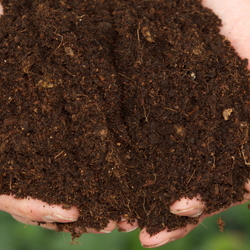- Obtain your soil sample by digging down 6 inches. Combine 3 such soil samples, as your soil may be different in different spots.
- Fill a quart canning jar with 1/2 cup of your soil sample.
- Dilute the sample by adding 1 & 1/2 cups of water.
- Add either 1/2 teaspoon of salt, or 1/2 teaspoon of dishwashing detergent.
- Cap the canning jar and shake for 2 minutes.
- Immediately after 2 minutes of shaking, pour the contents of the quart canning jar into your 2 cup Pyrex measuring cup.
- Allow the 2 cup Pyrex measuring cup to stand for exactly 30 seconds. Measure the height in ounces (or ml) of the soil particles that have settled at this time. This is the sand portion. Record this value.
- Allow the 2 cup Pyrex measuring cup to stand undisturbed for 30 minutes. Measure the height in ounces (or ml) of the soil particles that have settled at this time and record that value. Subtract the first (30 second) reading. This difference is the portion of soil that is silt.
- Now let the 2 cup Pyrex measuring cup of soil stand for at least 24 hours. At the 24-hour point, take another reading. Subtract the height at the 30 minute reading. This difference is the clay portion of the soil. If the water is still very cloudy, take another reading after it has completely cleared. Compare it to the 24-hour reading. If the level has risen, subtract the 30-minute reading from this value, and use this for the clay reading.
- Now, put the three height readings in the form of percentages. For example;
| Height in ounces after: | Corresponds to fraction of: | Example - total height in ounces: | Difference in height, or portion: | Portions expressed as percentage: |
| 30 seconds | sand | 4 oz | 4 oz | 4/8 = 50 % |
| 30 minutes | silt | 5 oz | 1 oz | 1/8 = 12.5 % |
| 24+ hours | clay | 8 oz | 3 oz | 3/8 = 37.5 % |
| total = 8 oz |
Using the soil texture triangle, find the spot on the diagram that corresponds to the fractions of sand, silt and clay in your soil test. Write down the name of your soil texture. In the example, the soil texture as determined by the triangle for a soil with 50% sand, 12.5% silt and 37.5% clay is a Sandy Clay Soil. You can now use this soil texture classification when estimating water, and fertility requirements of your soil, as well as choosing the best ammendment for your soil.
A sandy soil is one with large particles that drains quickly but holds nutrients poorly.
A clay soil is composed of extremely small particles, with a large capacity for holding water and dissolved plant nutrients. Un amended clay soil is sticky, heavy, and hard to breathe. It tends to expand when wet and crack apart when dry.
A silt soil is one with medium-size mineral particles, larger than clay and smaller than sand. Silt adds little to the characteristics of a soil.
The term loam refers to a soil with a combination of sand, silt, and clay sized particles.
Originally published at Reply42.com/garden Soil Tilth, permission granted to Dave's Garden for reuse.
Linda-reply42
















